HUMAN RESOURCE MANAGEMENT: Cross-Cultural Differences Analysis Report
VerifiedAdded on 2022/09/29
|12
|2533
|18
Report
AI Summary
This report provides an analysis of cross-cultural differences within the realm of Human Resource Management (HRM). It begins with an executive summary and introduction that emphasizes the importance of adapting HRM practices to different cultural contexts. The report then delves into the core concepts of International Human Resource Management (IHRM), including recruitment, selection, training, and development. It explores Hofstede's theory to understand cultural dimensions and their impact on HRM practices. The report also presents practical comparisons between different countries, such as the USA and Bangladesh, in terms of recruitment and training approaches. It further examines the positive and negative impacts of cross-cultural differences in the workplace, including the challenges and benefits associated with globalization. The report concludes by highlighting the importance of understanding and managing cultural differences to achieve organizational success in a globalized environment.
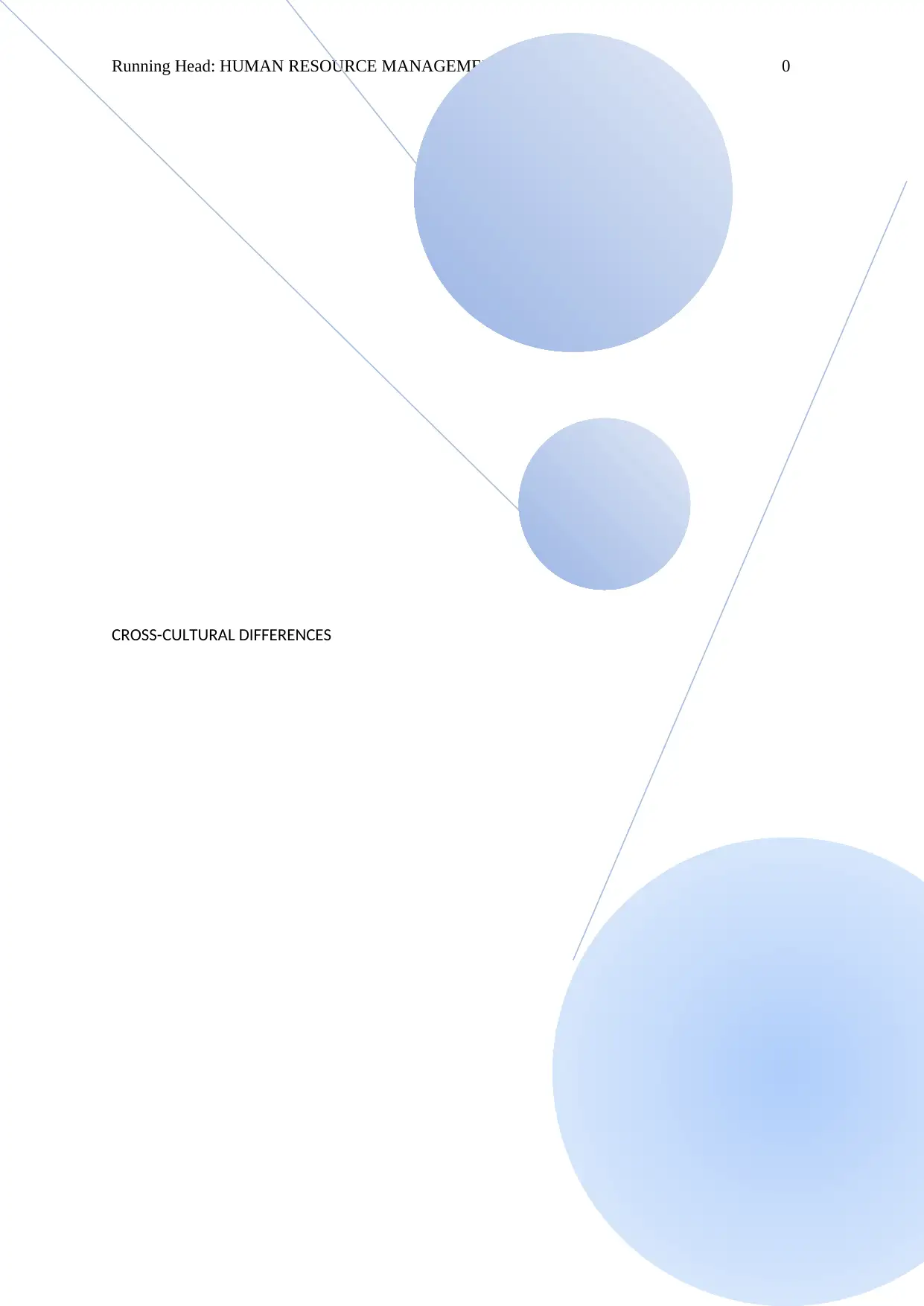
Running Head: HUMAN RESOURCE MANAGEMENT 0
CROSS-CULTURAL DIFFERENCES
CROSS-CULTURAL DIFFERENCES
Paraphrase This Document
Need a fresh take? Get an instant paraphrase of this document with our AI Paraphraser
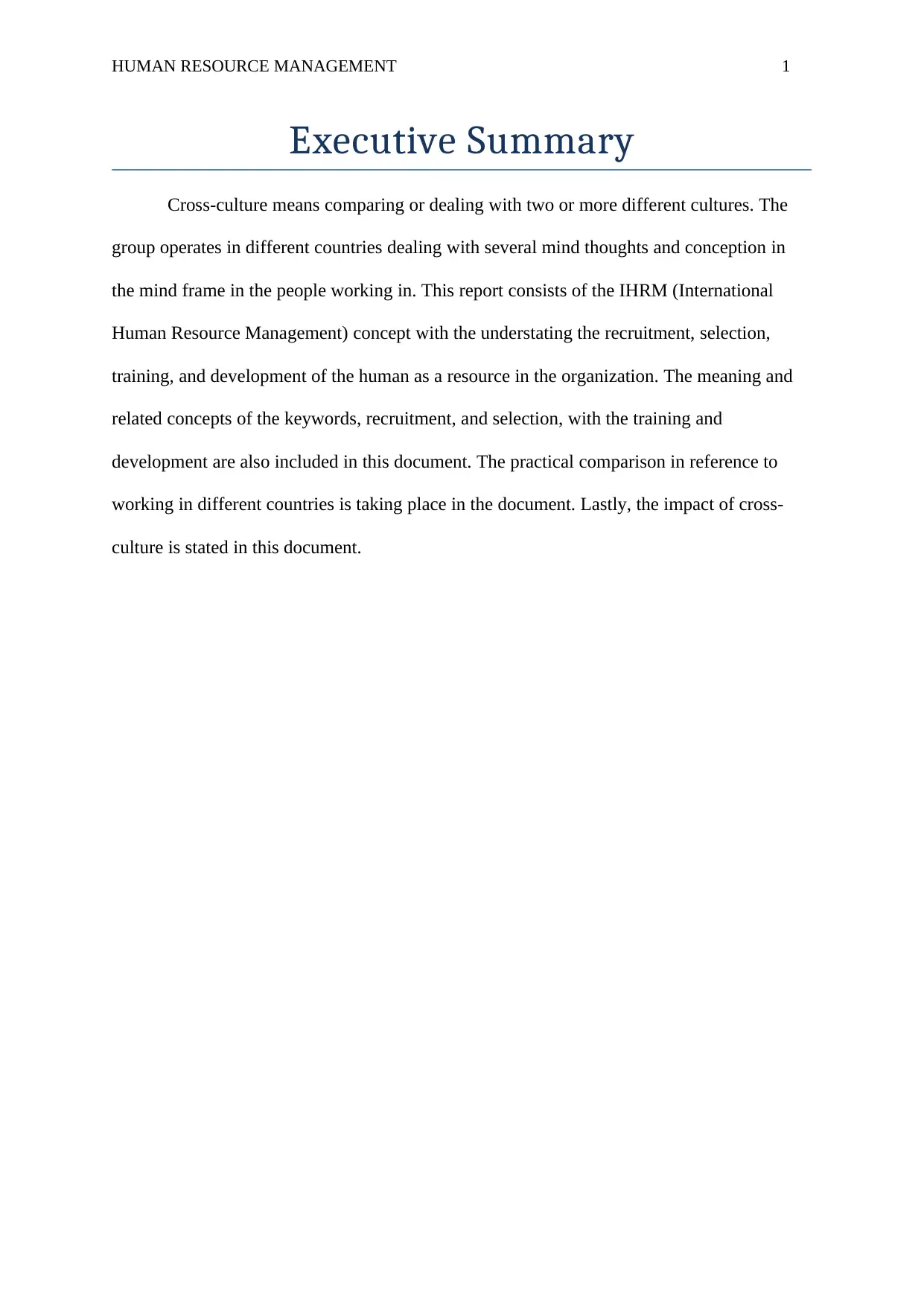
HUMAN RESOURCE MANAGEMENT 1
Executive Summary
Cross-culture means comparing or dealing with two or more different cultures. The
group operates in different countries dealing with several mind thoughts and conception in
the mind frame in the people working in. This report consists of the IHRM (International
Human Resource Management) concept with the understating the recruitment, selection,
training, and development of the human as a resource in the organization. The meaning and
related concepts of the keywords, recruitment, and selection, with the training and
development are also included in this document. The practical comparison in reference to
working in different countries is taking place in the document. Lastly, the impact of cross-
culture is stated in this document.
Executive Summary
Cross-culture means comparing or dealing with two or more different cultures. The
group operates in different countries dealing with several mind thoughts and conception in
the mind frame in the people working in. This report consists of the IHRM (International
Human Resource Management) concept with the understating the recruitment, selection,
training, and development of the human as a resource in the organization. The meaning and
related concepts of the keywords, recruitment, and selection, with the training and
development are also included in this document. The practical comparison in reference to
working in different countries is taking place in the document. Lastly, the impact of cross-
culture is stated in this document.
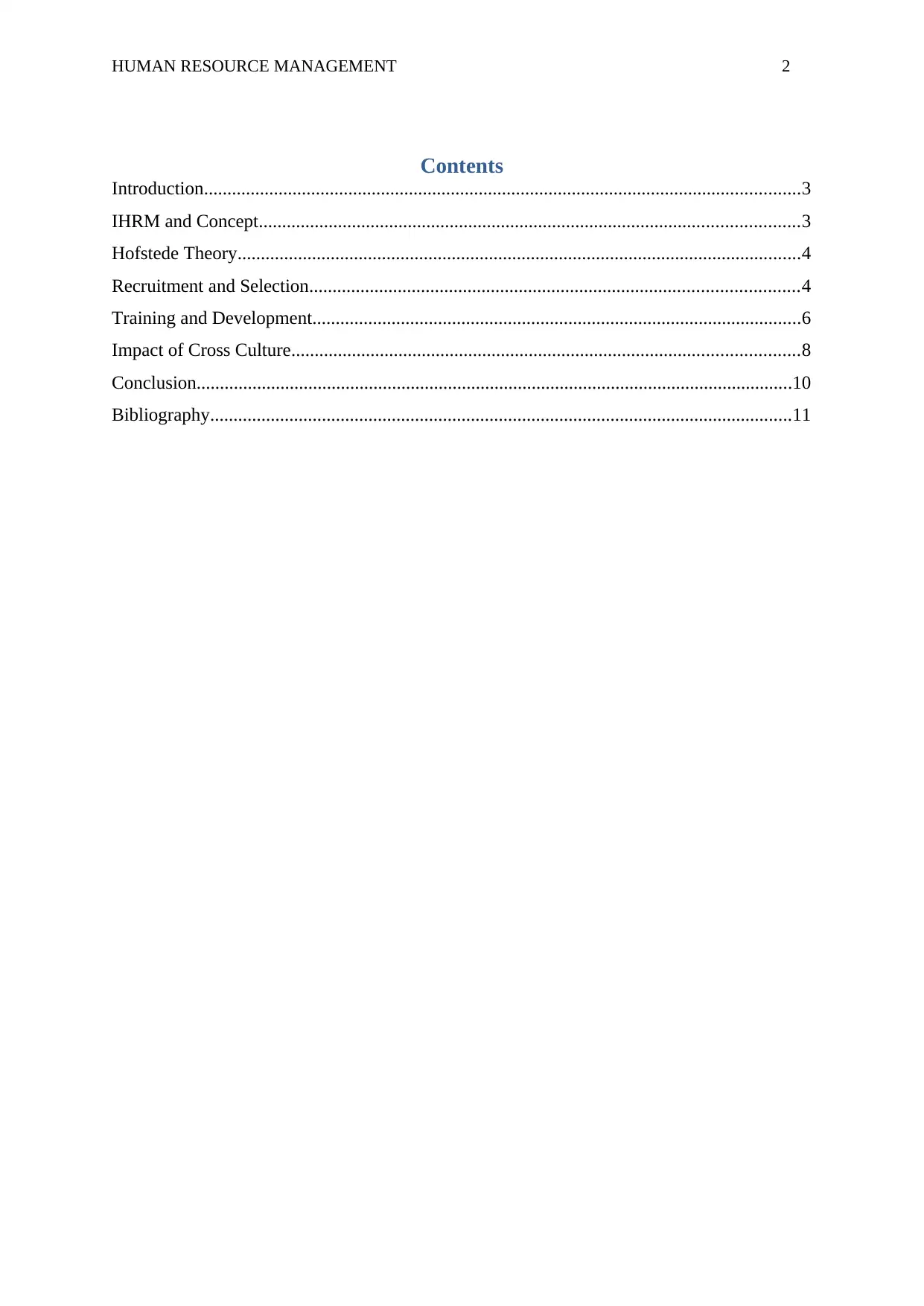
HUMAN RESOURCE MANAGEMENT 2
Contents
Introduction................................................................................................................................3
IHRM and Concept....................................................................................................................3
Hofstede Theory.........................................................................................................................4
Recruitment and Selection.........................................................................................................4
Training and Development.........................................................................................................6
Impact of Cross Culture.............................................................................................................8
Conclusion................................................................................................................................10
Bibliography.............................................................................................................................11
Contents
Introduction................................................................................................................................3
IHRM and Concept....................................................................................................................3
Hofstede Theory.........................................................................................................................4
Recruitment and Selection.........................................................................................................4
Training and Development.........................................................................................................6
Impact of Cross Culture.............................................................................................................8
Conclusion................................................................................................................................10
Bibliography.............................................................................................................................11
⊘ This is a preview!⊘
Do you want full access?
Subscribe today to unlock all pages.

Trusted by 1+ million students worldwide
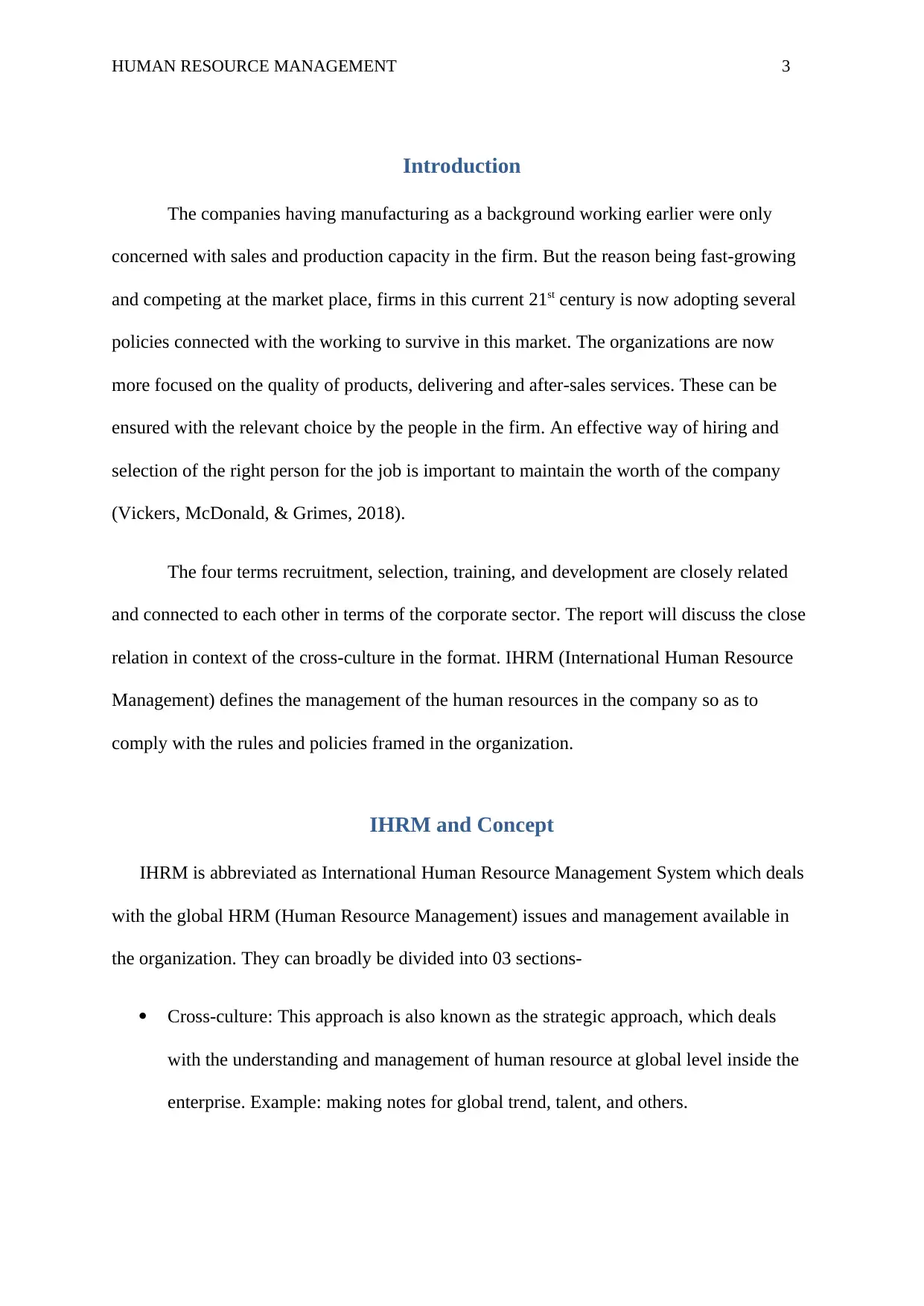
HUMAN RESOURCE MANAGEMENT 3
Introduction
The companies having manufacturing as a background working earlier were only
concerned with sales and production capacity in the firm. But the reason being fast-growing
and competing at the market place, firms in this current 21st century is now adopting several
policies connected with the working to survive in this market. The organizations are now
more focused on the quality of products, delivering and after-sales services. These can be
ensured with the relevant choice by the people in the firm. An effective way of hiring and
selection of the right person for the job is important to maintain the worth of the company
(Vickers, McDonald, & Grimes, 2018).
The four terms recruitment, selection, training, and development are closely related
and connected to each other in terms of the corporate sector. The report will discuss the close
relation in context of the cross-culture in the format. IHRM (International Human Resource
Management) defines the management of the human resources in the company so as to
comply with the rules and policies framed in the organization.
IHRM and Concept
IHRM is abbreviated as International Human Resource Management System which deals
with the global HRM (Human Resource Management) issues and management available in
the organization. They can broadly be divided into 03 sections-
Cross-culture: This approach is also known as the strategic approach, which deals
with the understanding and management of human resource at global level inside the
enterprise. Example: making notes for global trend, talent, and others.
Introduction
The companies having manufacturing as a background working earlier were only
concerned with sales and production capacity in the firm. But the reason being fast-growing
and competing at the market place, firms in this current 21st century is now adopting several
policies connected with the working to survive in this market. The organizations are now
more focused on the quality of products, delivering and after-sales services. These can be
ensured with the relevant choice by the people in the firm. An effective way of hiring and
selection of the right person for the job is important to maintain the worth of the company
(Vickers, McDonald, & Grimes, 2018).
The four terms recruitment, selection, training, and development are closely related
and connected to each other in terms of the corporate sector. The report will discuss the close
relation in context of the cross-culture in the format. IHRM (International Human Resource
Management) defines the management of the human resources in the company so as to
comply with the rules and policies framed in the organization.
IHRM and Concept
IHRM is abbreviated as International Human Resource Management System which deals
with the global HRM (Human Resource Management) issues and management available in
the organization. They can broadly be divided into 03 sections-
Cross-culture: This approach is also known as the strategic approach, which deals
with the understanding and management of human resource at global level inside the
enterprise. Example: making notes for global trend, talent, and others.
Paraphrase This Document
Need a fresh take? Get an instant paraphrase of this document with our AI Paraphraser
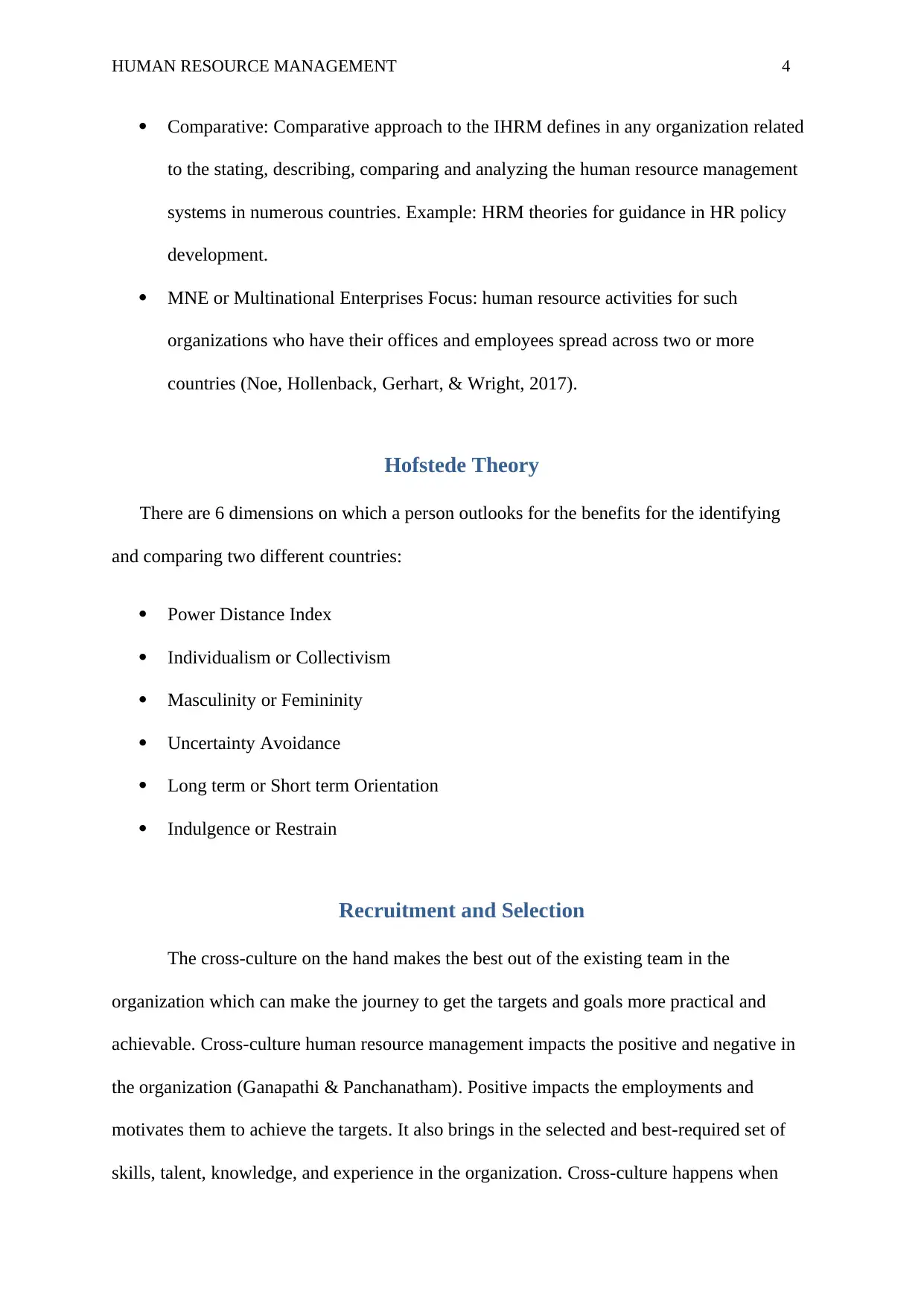
HUMAN RESOURCE MANAGEMENT 4
Comparative: Comparative approach to the IHRM defines in any organization related
to the stating, describing, comparing and analyzing the human resource management
systems in numerous countries. Example: HRM theories for guidance in HR policy
development.
MNE or Multinational Enterprises Focus: human resource activities for such
organizations who have their offices and employees spread across two or more
countries (Noe, Hollenback, Gerhart, & Wright, 2017).
Hofstede Theory
There are 6 dimensions on which a person outlooks for the benefits for the identifying
and comparing two different countries:
Power Distance Index
Individualism or Collectivism
Masculinity or Femininity
Uncertainty Avoidance
Long term or Short term Orientation
Indulgence or Restrain
Recruitment and Selection
The cross-culture on the hand makes the best out of the existing team in the
organization which can make the journey to get the targets and goals more practical and
achievable. Cross-culture human resource management impacts the positive and negative in
the organization (Ganapathi & Panchanatham). Positive impacts the employments and
motivates them to achieve the targets. It also brings in the selected and best-required set of
skills, talent, knowledge, and experience in the organization. Cross-culture happens when
Comparative: Comparative approach to the IHRM defines in any organization related
to the stating, describing, comparing and analyzing the human resource management
systems in numerous countries. Example: HRM theories for guidance in HR policy
development.
MNE or Multinational Enterprises Focus: human resource activities for such
organizations who have their offices and employees spread across two or more
countries (Noe, Hollenback, Gerhart, & Wright, 2017).
Hofstede Theory
There are 6 dimensions on which a person outlooks for the benefits for the identifying
and comparing two different countries:
Power Distance Index
Individualism or Collectivism
Masculinity or Femininity
Uncertainty Avoidance
Long term or Short term Orientation
Indulgence or Restrain
Recruitment and Selection
The cross-culture on the hand makes the best out of the existing team in the
organization which can make the journey to get the targets and goals more practical and
achievable. Cross-culture human resource management impacts the positive and negative in
the organization (Ganapathi & Panchanatham). Positive impacts the employments and
motivates them to achieve the targets. It also brings in the selected and best-required set of
skills, talent, knowledge, and experience in the organization. Cross-culture happens when
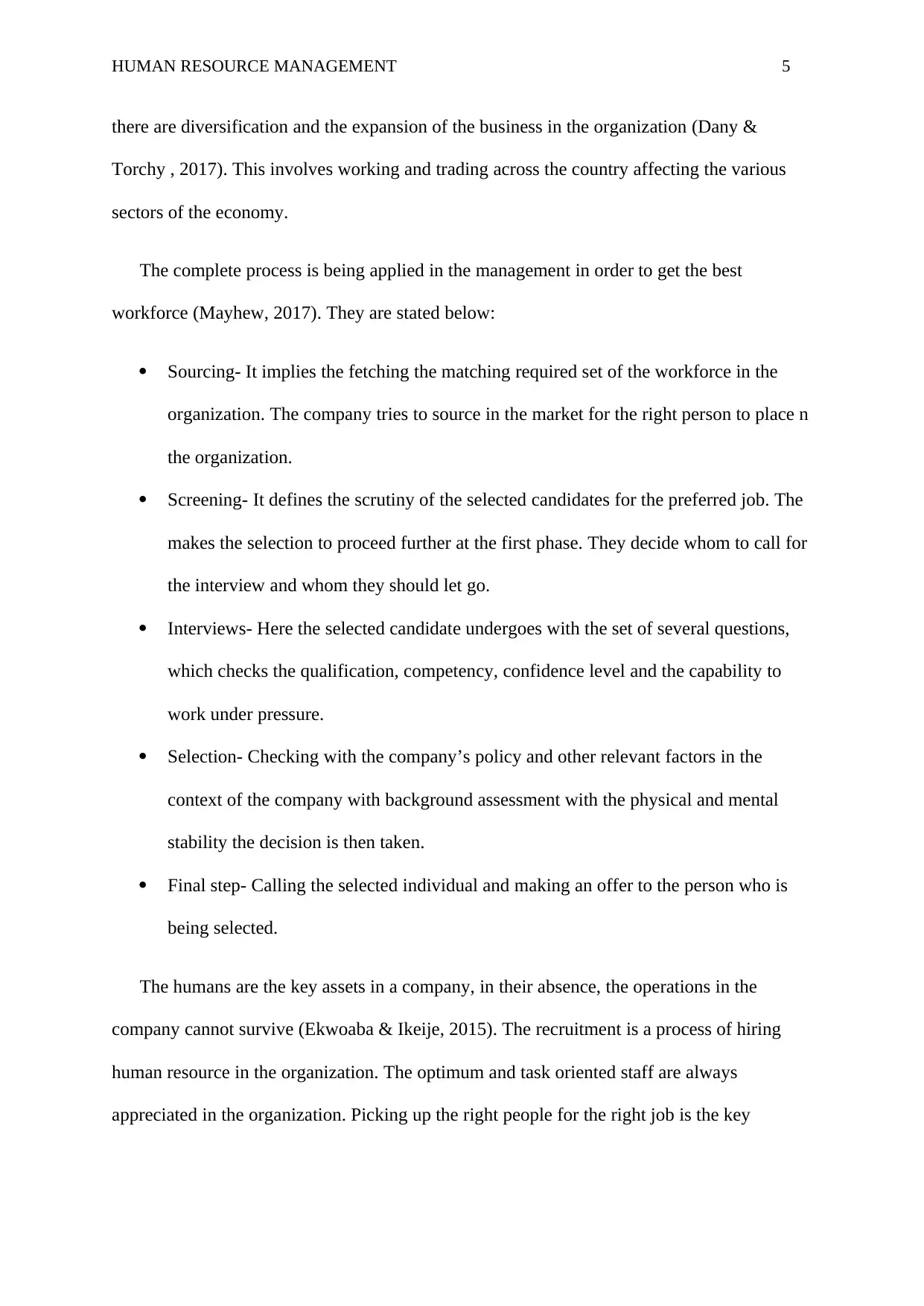
HUMAN RESOURCE MANAGEMENT 5
there are diversification and the expansion of the business in the organization (Dany &
Torchy , 2017). This involves working and trading across the country affecting the various
sectors of the economy.
The complete process is being applied in the management in order to get the best
workforce (Mayhew, 2017). They are stated below:
Sourcing- It implies the fetching the matching required set of the workforce in the
organization. The company tries to source in the market for the right person to place n
the organization.
Screening- It defines the scrutiny of the selected candidates for the preferred job. The
makes the selection to proceed further at the first phase. They decide whom to call for
the interview and whom they should let go.
Interviews- Here the selected candidate undergoes with the set of several questions,
which checks the qualification, competency, confidence level and the capability to
work under pressure.
Selection- Checking with the company’s policy and other relevant factors in the
context of the company with background assessment with the physical and mental
stability the decision is then taken.
Final step- Calling the selected individual and making an offer to the person who is
being selected.
The humans are the key assets in a company, in their absence, the operations in the
company cannot survive (Ekwoaba & Ikeije, 2015). The recruitment is a process of hiring
human resource in the organization. The optimum and task oriented staff are always
appreciated in the organization. Picking up the right people for the right job is the key
there are diversification and the expansion of the business in the organization (Dany &
Torchy , 2017). This involves working and trading across the country affecting the various
sectors of the economy.
The complete process is being applied in the management in order to get the best
workforce (Mayhew, 2017). They are stated below:
Sourcing- It implies the fetching the matching required set of the workforce in the
organization. The company tries to source in the market for the right person to place n
the organization.
Screening- It defines the scrutiny of the selected candidates for the preferred job. The
makes the selection to proceed further at the first phase. They decide whom to call for
the interview and whom they should let go.
Interviews- Here the selected candidate undergoes with the set of several questions,
which checks the qualification, competency, confidence level and the capability to
work under pressure.
Selection- Checking with the company’s policy and other relevant factors in the
context of the company with background assessment with the physical and mental
stability the decision is then taken.
Final step- Calling the selected individual and making an offer to the person who is
being selected.
The humans are the key assets in a company, in their absence, the operations in the
company cannot survive (Ekwoaba & Ikeije, 2015). The recruitment is a process of hiring
human resource in the organization. The optimum and task oriented staff are always
appreciated in the organization. Picking up the right people for the right job is the key
⊘ This is a preview!⊘
Do you want full access?
Subscribe today to unlock all pages.

Trusted by 1+ million students worldwide
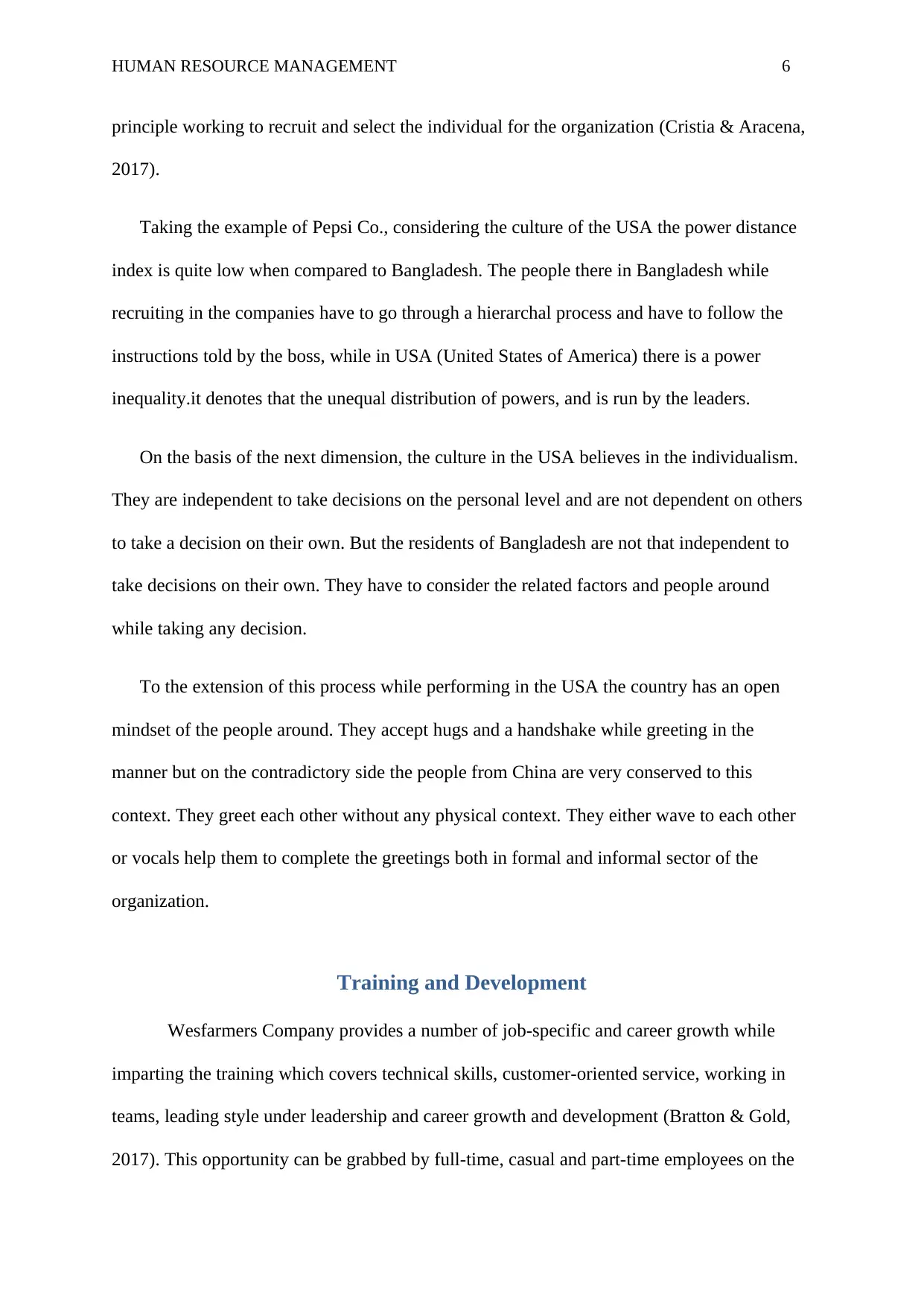
HUMAN RESOURCE MANAGEMENT 6
principle working to recruit and select the individual for the organization (Cristia & Aracena,
2017).
Taking the example of Pepsi Co., considering the culture of the USA the power distance
index is quite low when compared to Bangladesh. The people there in Bangladesh while
recruiting in the companies have to go through a hierarchal process and have to follow the
instructions told by the boss, while in USA (United States of America) there is a power
inequality.it denotes that the unequal distribution of powers, and is run by the leaders.
On the basis of the next dimension, the culture in the USA believes in the individualism.
They are independent to take decisions on the personal level and are not dependent on others
to take a decision on their own. But the residents of Bangladesh are not that independent to
take decisions on their own. They have to consider the related factors and people around
while taking any decision.
To the extension of this process while performing in the USA the country has an open
mindset of the people around. They accept hugs and a handshake while greeting in the
manner but on the contradictory side the people from China are very conserved to this
context. They greet each other without any physical context. They either wave to each other
or vocals help them to complete the greetings both in formal and informal sector of the
organization.
Training and Development
Wesfarmers Company provides a number of job-specific and career growth while
imparting the training which covers technical skills, customer-oriented service, working in
teams, leading style under leadership and career growth and development (Bratton & Gold,
2017). This opportunity can be grabbed by full-time, casual and part-time employees on the
principle working to recruit and select the individual for the organization (Cristia & Aracena,
2017).
Taking the example of Pepsi Co., considering the culture of the USA the power distance
index is quite low when compared to Bangladesh. The people there in Bangladesh while
recruiting in the companies have to go through a hierarchal process and have to follow the
instructions told by the boss, while in USA (United States of America) there is a power
inequality.it denotes that the unequal distribution of powers, and is run by the leaders.
On the basis of the next dimension, the culture in the USA believes in the individualism.
They are independent to take decisions on the personal level and are not dependent on others
to take a decision on their own. But the residents of Bangladesh are not that independent to
take decisions on their own. They have to consider the related factors and people around
while taking any decision.
To the extension of this process while performing in the USA the country has an open
mindset of the people around. They accept hugs and a handshake while greeting in the
manner but on the contradictory side the people from China are very conserved to this
context. They greet each other without any physical context. They either wave to each other
or vocals help them to complete the greetings both in formal and informal sector of the
organization.
Training and Development
Wesfarmers Company provides a number of job-specific and career growth while
imparting the training which covers technical skills, customer-oriented service, working in
teams, leading style under leadership and career growth and development (Bratton & Gold,
2017). This opportunity can be grabbed by full-time, casual and part-time employees on the
Paraphrase This Document
Need a fresh take? Get an instant paraphrase of this document with our AI Paraphraser
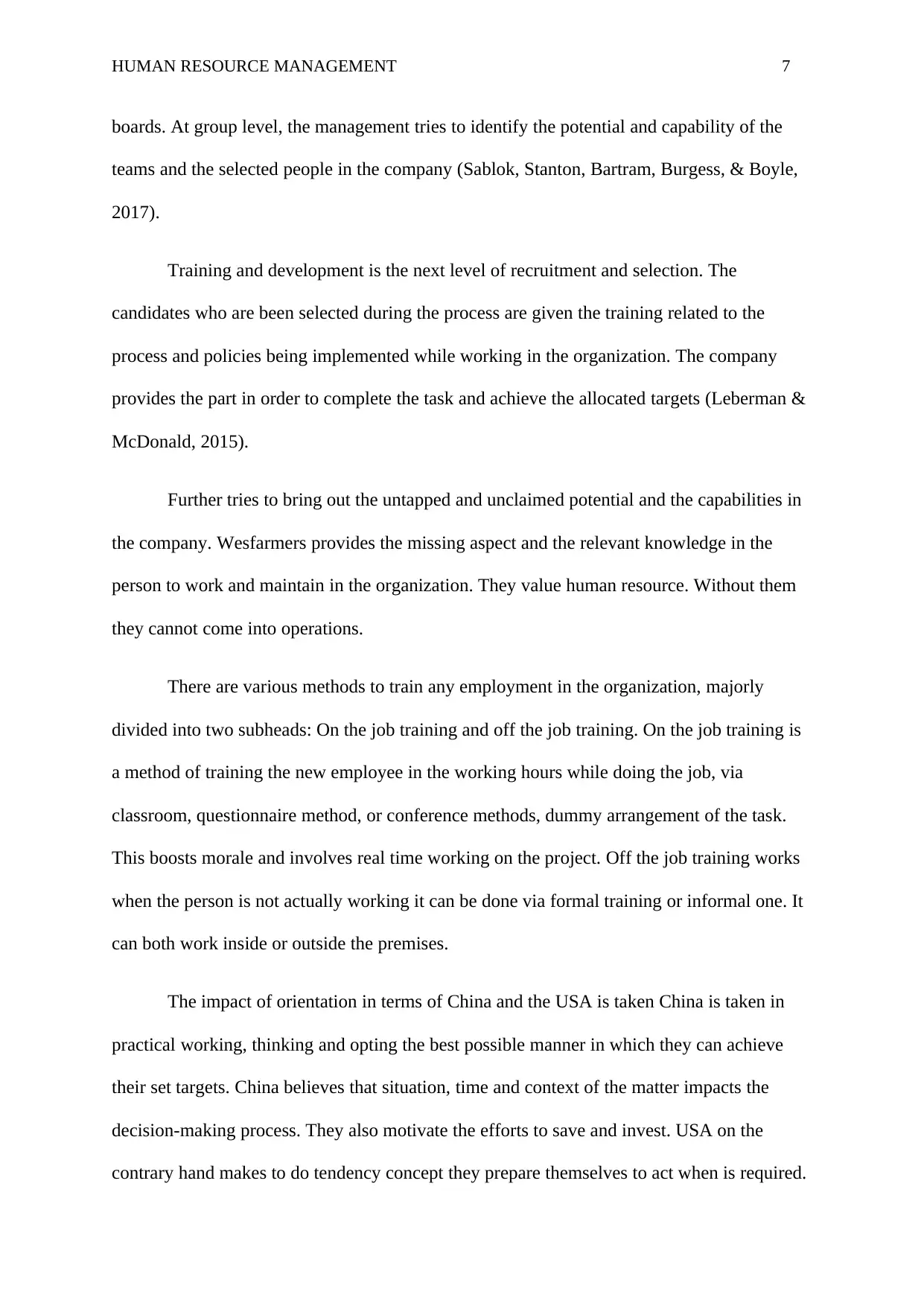
HUMAN RESOURCE MANAGEMENT 7
boards. At group level, the management tries to identify the potential and capability of the
teams and the selected people in the company (Sablok, Stanton, Bartram, Burgess, & Boyle,
2017).
Training and development is the next level of recruitment and selection. The
candidates who are been selected during the process are given the training related to the
process and policies being implemented while working in the organization. The company
provides the part in order to complete the task and achieve the allocated targets (Leberman &
McDonald, 2015).
Further tries to bring out the untapped and unclaimed potential and the capabilities in
the company. Wesfarmers provides the missing aspect and the relevant knowledge in the
person to work and maintain in the organization. They value human resource. Without them
they cannot come into operations.
There are various methods to train any employment in the organization, majorly
divided into two subheads: On the job training and off the job training. On the job training is
a method of training the new employee in the working hours while doing the job, via
classroom, questionnaire method, or conference methods, dummy arrangement of the task.
This boosts morale and involves real time working on the project. Off the job training works
when the person is not actually working it can be done via formal training or informal one. It
can both work inside or outside the premises.
The impact of orientation in terms of China and the USA is taken China is taken in
practical working, thinking and opting the best possible manner in which they can achieve
their set targets. China believes that situation, time and context of the matter impacts the
decision-making process. They also motivate the efforts to save and invest. USA on the
contrary hand makes to do tendency concept they prepare themselves to act when is required.
boards. At group level, the management tries to identify the potential and capability of the
teams and the selected people in the company (Sablok, Stanton, Bartram, Burgess, & Boyle,
2017).
Training and development is the next level of recruitment and selection. The
candidates who are been selected during the process are given the training related to the
process and policies being implemented while working in the organization. The company
provides the part in order to complete the task and achieve the allocated targets (Leberman &
McDonald, 2015).
Further tries to bring out the untapped and unclaimed potential and the capabilities in
the company. Wesfarmers provides the missing aspect and the relevant knowledge in the
person to work and maintain in the organization. They value human resource. Without them
they cannot come into operations.
There are various methods to train any employment in the organization, majorly
divided into two subheads: On the job training and off the job training. On the job training is
a method of training the new employee in the working hours while doing the job, via
classroom, questionnaire method, or conference methods, dummy arrangement of the task.
This boosts morale and involves real time working on the project. Off the job training works
when the person is not actually working it can be done via formal training or informal one. It
can both work inside or outside the premises.
The impact of orientation in terms of China and the USA is taken China is taken in
practical working, thinking and opting the best possible manner in which they can achieve
their set targets. China believes that situation, time and context of the matter impacts the
decision-making process. They also motivate the efforts to save and invest. USA on the
contrary hand makes to do tendency concept they prepare themselves to act when is required.
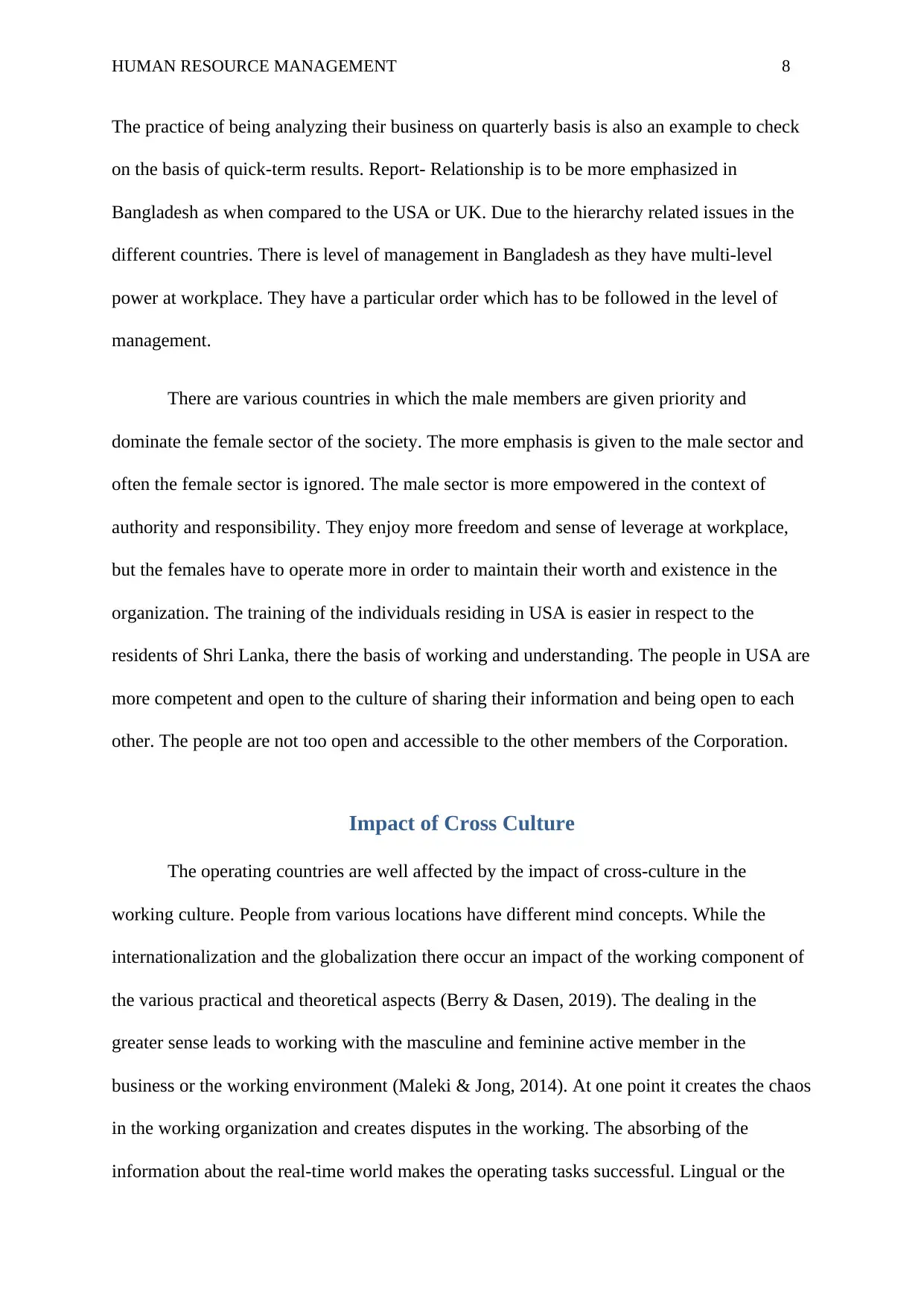
HUMAN RESOURCE MANAGEMENT 8
The practice of being analyzing their business on quarterly basis is also an example to check
on the basis of quick-term results. Report- Relationship is to be more emphasized in
Bangladesh as when compared to the USA or UK. Due to the hierarchy related issues in the
different countries. There is level of management in Bangladesh as they have multi-level
power at workplace. They have a particular order which has to be followed in the level of
management.
There are various countries in which the male members are given priority and
dominate the female sector of the society. The more emphasis is given to the male sector and
often the female sector is ignored. The male sector is more empowered in the context of
authority and responsibility. They enjoy more freedom and sense of leverage at workplace,
but the females have to operate more in order to maintain their worth and existence in the
organization. The training of the individuals residing in USA is easier in respect to the
residents of Shri Lanka, there the basis of working and understanding. The people in USA are
more competent and open to the culture of sharing their information and being open to each
other. The people are not too open and accessible to the other members of the Corporation.
Impact of Cross Culture
The operating countries are well affected by the impact of cross-culture in the
working culture. People from various locations have different mind concepts. While the
internationalization and the globalization there occur an impact of the working component of
the various practical and theoretical aspects (Berry & Dasen, 2019). The dealing in the
greater sense leads to working with the masculine and feminine active member in the
business or the working environment (Maleki & Jong, 2014). At one point it creates the chaos
in the working organization and creates disputes in the working. The absorbing of the
information about the real-time world makes the operating tasks successful. Lingual or the
The practice of being analyzing their business on quarterly basis is also an example to check
on the basis of quick-term results. Report- Relationship is to be more emphasized in
Bangladesh as when compared to the USA or UK. Due to the hierarchy related issues in the
different countries. There is level of management in Bangladesh as they have multi-level
power at workplace. They have a particular order which has to be followed in the level of
management.
There are various countries in which the male members are given priority and
dominate the female sector of the society. The more emphasis is given to the male sector and
often the female sector is ignored. The male sector is more empowered in the context of
authority and responsibility. They enjoy more freedom and sense of leverage at workplace,
but the females have to operate more in order to maintain their worth and existence in the
organization. The training of the individuals residing in USA is easier in respect to the
residents of Shri Lanka, there the basis of working and understanding. The people in USA are
more competent and open to the culture of sharing their information and being open to each
other. The people are not too open and accessible to the other members of the Corporation.
Impact of Cross Culture
The operating countries are well affected by the impact of cross-culture in the
working culture. People from various locations have different mind concepts. While the
internationalization and the globalization there occur an impact of the working component of
the various practical and theoretical aspects (Berry & Dasen, 2019). The dealing in the
greater sense leads to working with the masculine and feminine active member in the
business or the working environment (Maleki & Jong, 2014). At one point it creates the chaos
in the working organization and creates disputes in the working. The absorbing of the
information about the real-time world makes the operating tasks successful. Lingual or the
⊘ This is a preview!⊘
Do you want full access?
Subscribe today to unlock all pages.

Trusted by 1+ million students worldwide
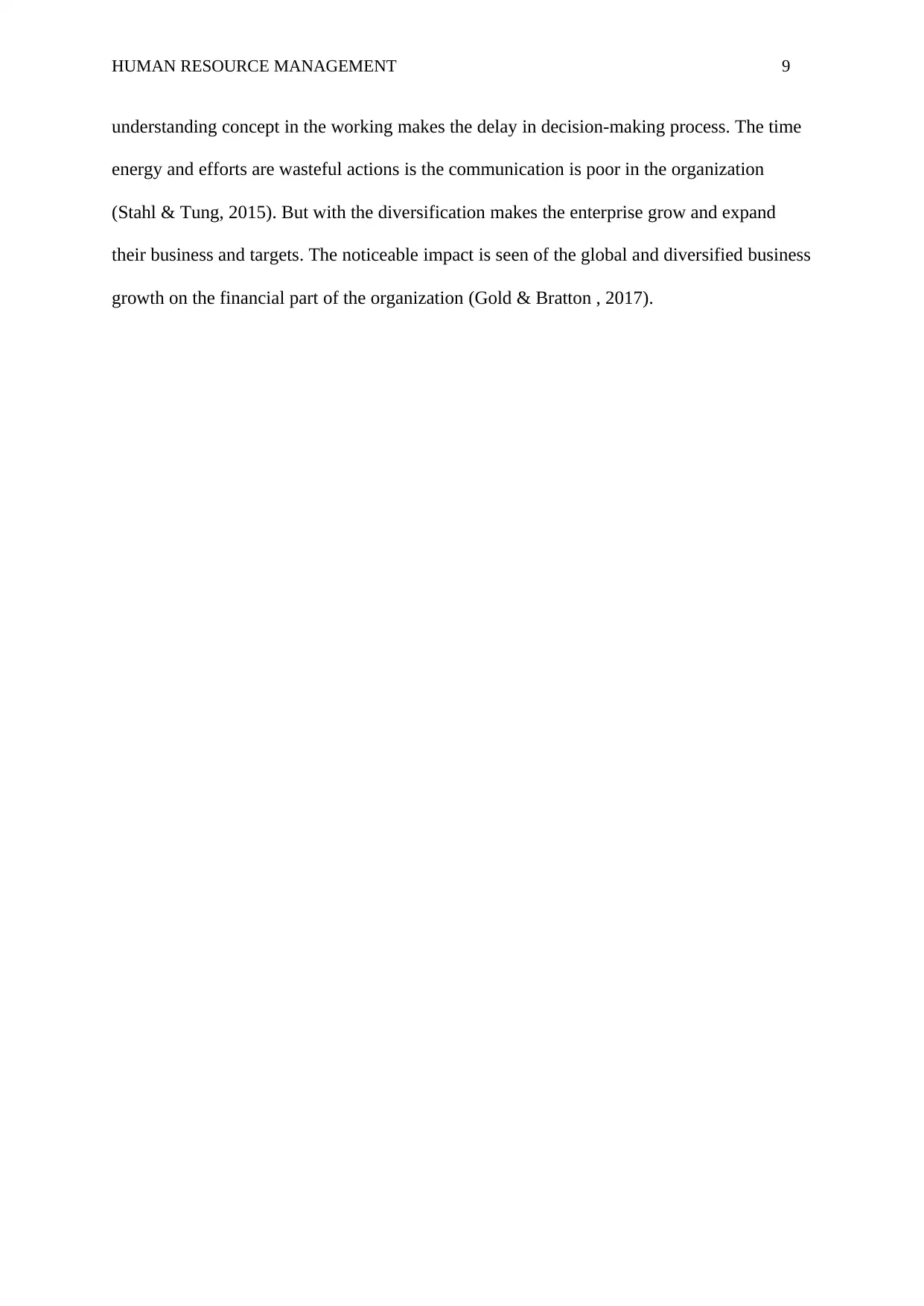
HUMAN RESOURCE MANAGEMENT 9
understanding concept in the working makes the delay in decision-making process. The time
energy and efforts are wasteful actions is the communication is poor in the organization
(Stahl & Tung, 2015). But with the diversification makes the enterprise grow and expand
their business and targets. The noticeable impact is seen of the global and diversified business
growth on the financial part of the organization (Gold & Bratton , 2017).
understanding concept in the working makes the delay in decision-making process. The time
energy and efforts are wasteful actions is the communication is poor in the organization
(Stahl & Tung, 2015). But with the diversification makes the enterprise grow and expand
their business and targets. The noticeable impact is seen of the global and diversified business
growth on the financial part of the organization (Gold & Bratton , 2017).
Paraphrase This Document
Need a fresh take? Get an instant paraphrase of this document with our AI Paraphraser
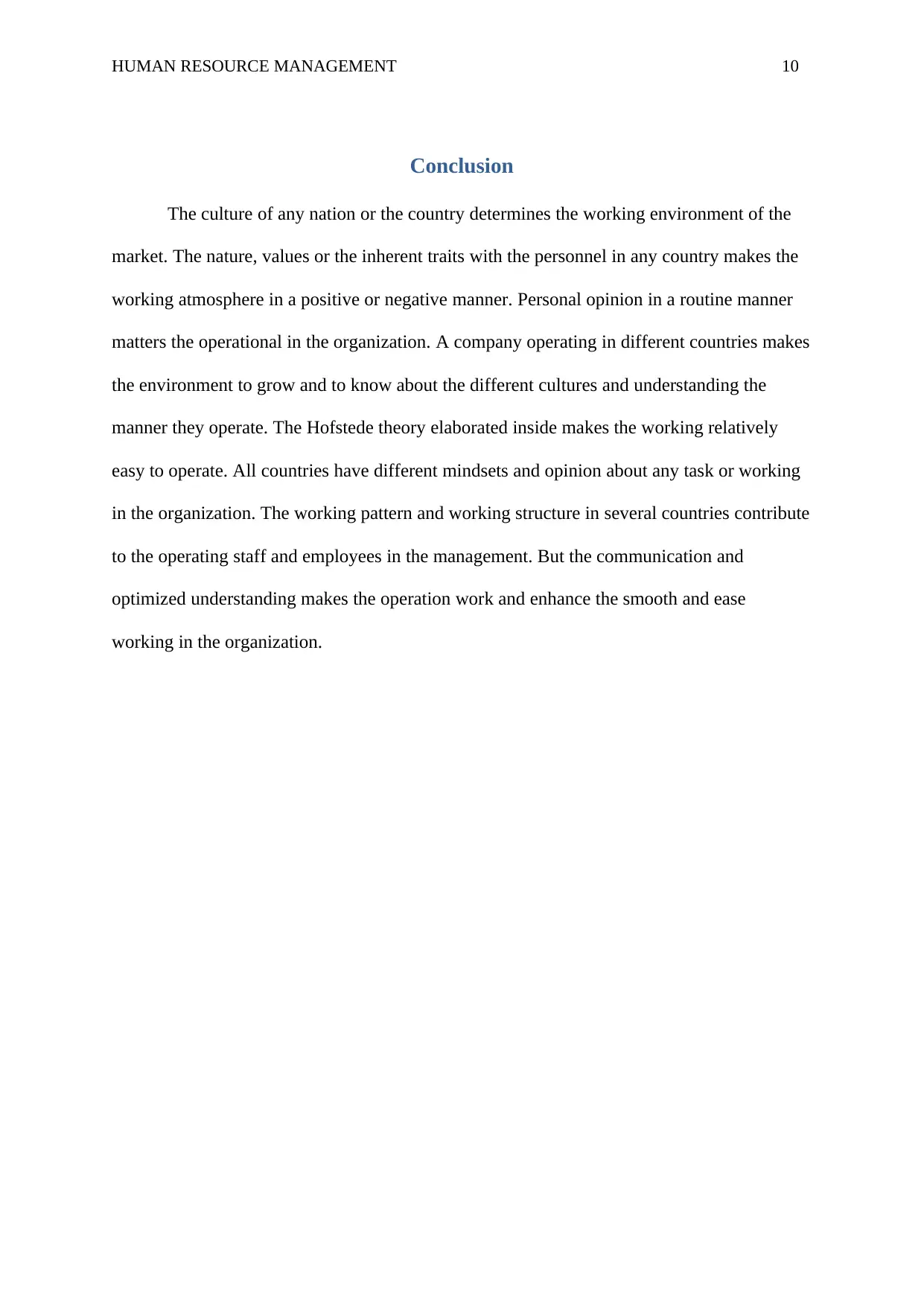
HUMAN RESOURCE MANAGEMENT 10
Conclusion
The culture of any nation or the country determines the working environment of the
market. The nature, values or the inherent traits with the personnel in any country makes the
working atmosphere in a positive or negative manner. Personal opinion in a routine manner
matters the operational in the organization. A company operating in different countries makes
the environment to grow and to know about the different cultures and understanding the
manner they operate. The Hofstede theory elaborated inside makes the working relatively
easy to operate. All countries have different mindsets and opinion about any task or working
in the organization. The working pattern and working structure in several countries contribute
to the operating staff and employees in the management. But the communication and
optimized understanding makes the operation work and enhance the smooth and ease
working in the organization.
Conclusion
The culture of any nation or the country determines the working environment of the
market. The nature, values or the inherent traits with the personnel in any country makes the
working atmosphere in a positive or negative manner. Personal opinion in a routine manner
matters the operational in the organization. A company operating in different countries makes
the environment to grow and to know about the different cultures and understanding the
manner they operate. The Hofstede theory elaborated inside makes the working relatively
easy to operate. All countries have different mindsets and opinion about any task or working
in the organization. The working pattern and working structure in several countries contribute
to the operating staff and employees in the management. But the communication and
optimized understanding makes the operation work and enhance the smooth and ease
working in the organization.
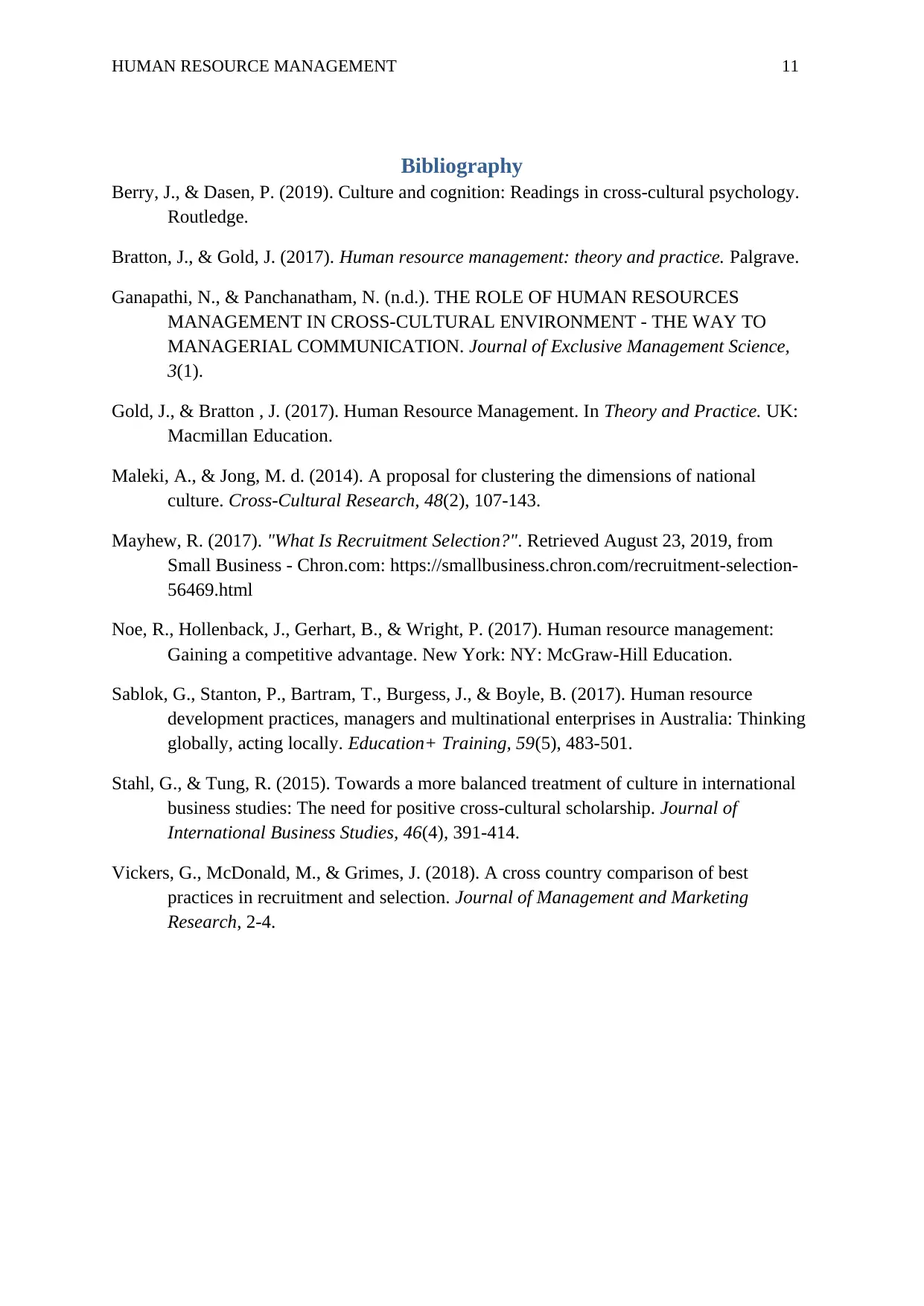
HUMAN RESOURCE MANAGEMENT 11
Bibliography
Berry, J., & Dasen, P. (2019). Culture and cognition: Readings in cross-cultural psychology.
Routledge.
Bratton, J., & Gold, J. (2017). Human resource management: theory and practice. Palgrave.
Ganapathi, N., & Panchanatham, N. (n.d.). THE ROLE OF HUMAN RESOURCES
MANAGEMENT IN CROSS-CULTURAL ENVIRONMENT - THE WAY TO
MANAGERIAL COMMUNICATION. Journal of Exclusive Management Science,
3(1).
Gold, J., & Bratton , J. (2017). Human Resource Management. In Theory and Practice. UK:
Macmillan Education.
Maleki, A., & Jong, M. d. (2014). A proposal for clustering the dimensions of national
culture. Cross-Cultural Research, 48(2), 107-143.
Mayhew, R. (2017). "What Is Recruitment Selection?". Retrieved August 23, 2019, from
Small Business - Chron.com: https://smallbusiness.chron.com/recruitment-selection-
56469.html
Noe, R., Hollenback, J., Gerhart, B., & Wright, P. (2017). Human resource management:
Gaining a competitive advantage. New York: NY: McGraw-Hill Education.
Sablok, G., Stanton, P., Bartram, T., Burgess, J., & Boyle, B. (2017). Human resource
development practices, managers and multinational enterprises in Australia: Thinking
globally, acting locally. Education+ Training, 59(5), 483-501.
Stahl, G., & Tung, R. (2015). Towards a more balanced treatment of culture in international
business studies: The need for positive cross-cultural scholarship. Journal of
International Business Studies, 46(4), 391-414.
Vickers, G., McDonald, M., & Grimes, J. (2018). A cross country comparison of best
practices in recruitment and selection. Journal of Management and Marketing
Research, 2-4.
Bibliography
Berry, J., & Dasen, P. (2019). Culture and cognition: Readings in cross-cultural psychology.
Routledge.
Bratton, J., & Gold, J. (2017). Human resource management: theory and practice. Palgrave.
Ganapathi, N., & Panchanatham, N. (n.d.). THE ROLE OF HUMAN RESOURCES
MANAGEMENT IN CROSS-CULTURAL ENVIRONMENT - THE WAY TO
MANAGERIAL COMMUNICATION. Journal of Exclusive Management Science,
3(1).
Gold, J., & Bratton , J. (2017). Human Resource Management. In Theory and Practice. UK:
Macmillan Education.
Maleki, A., & Jong, M. d. (2014). A proposal for clustering the dimensions of national
culture. Cross-Cultural Research, 48(2), 107-143.
Mayhew, R. (2017). "What Is Recruitment Selection?". Retrieved August 23, 2019, from
Small Business - Chron.com: https://smallbusiness.chron.com/recruitment-selection-
56469.html
Noe, R., Hollenback, J., Gerhart, B., & Wright, P. (2017). Human resource management:
Gaining a competitive advantage. New York: NY: McGraw-Hill Education.
Sablok, G., Stanton, P., Bartram, T., Burgess, J., & Boyle, B. (2017). Human resource
development practices, managers and multinational enterprises in Australia: Thinking
globally, acting locally. Education+ Training, 59(5), 483-501.
Stahl, G., & Tung, R. (2015). Towards a more balanced treatment of culture in international
business studies: The need for positive cross-cultural scholarship. Journal of
International Business Studies, 46(4), 391-414.
Vickers, G., McDonald, M., & Grimes, J. (2018). A cross country comparison of best
practices in recruitment and selection. Journal of Management and Marketing
Research, 2-4.
⊘ This is a preview!⊘
Do you want full access?
Subscribe today to unlock all pages.

Trusted by 1+ million students worldwide
1 out of 12
Related Documents
Your All-in-One AI-Powered Toolkit for Academic Success.
+13062052269
info@desklib.com
Available 24*7 on WhatsApp / Email
![[object Object]](/_next/static/media/star-bottom.7253800d.svg)
Unlock your academic potential
Copyright © 2020–2025 A2Z Services. All Rights Reserved. Developed and managed by ZUCOL.




